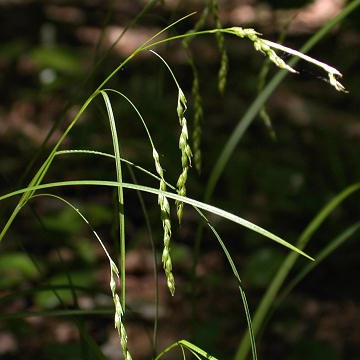

Carex debilis - (image 1 of 6)
Taxonomy
Family: Cyperaceae
Section Hymenochlaenae
Habitat
Woods and swamps.
Associates
Distribution
Newfoundland west to northern MI and WI, south to FL and TX.
Morphology
Tufted perennial to 1 m; stems purplish at the base; leaves 2-4 mm wide; staminate spike 2-4 cm, slender, sometimes with some distal perigynia; pistillate spikes 2-4, slender and spreading or nodding, to 6 cm long and 4 mm wide, loosely flowered; perigynia 5-6 mm, laceolate or narrowly ovoid, obscurely trigonous, 2-ribbed, obscurely several-nerved, separated by internodes 2-4 mm or more; pistillate scales oblong to obovate, half the length of the perigynia, margins hyaline or brownish, midvien narrow and green; achene trigonous with thickened angles, elevated above the perigynium-base on a slender stipe 0.5-1.5 mm.
Notes
Fruiting June to July
Wetland indicator: FACW
The specific epithet may be recognized as the root of the term "debilitated". The plant shown here is var. rudgei L.H. Bailey (Northern Weak Sedge), which is the most widespread variety. Typical C. debilis (Southern Weak Sedge) does not occur quite as far north or west and has some perigynia over 6.9 mm long with beaks more or less erose and scarcely bidentate.
Carex arctata (Arctic Sedge) is somewhat similar but with the achene sessile in the base of the perigynium and the beak much shorter than the body of the perigynium. A superficially similar species is C. gracillima which flowers earlier in the season and has beakless perigynia.
The introduced Carex sylvatica might be confused with this species or C. arctata but the base of the culms are pale brown or ivory rather than reddish or purplish.
It has been suggested that the proper name for this plant is Carex flexuosa Muhl. ex Willd.
References
Gleason, Henry A. and A. Cronquist. 1991. Manual of Vascular Plants of
Northeastern United States and Adjacent Canada. Second Ed.
The New York Botanical Garden. Bronx, NY
Swink, F. and G. Wilhelm. 1994. Plants of the Chicago Region.
Indiana Academy of Science. The Morton Arboretum. Lisle, Illinois.
|
© Michael Hough 2010 |